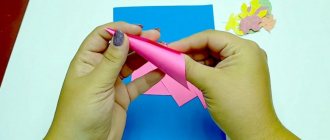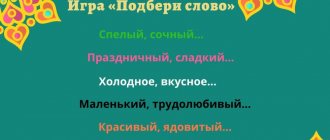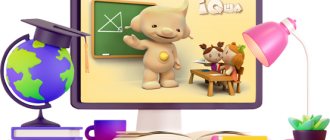Didactic games are a type of games with rules, specially created by pedagogy for the purpose of teaching and raising children. However, didactic games are also a game form of education, which, as is known, is quite actively used in the initial stages of education, i.e. in senior preschool and primary school age.
ON THE. Vinogradova noted that due to the age characteristics of preschool children, didactic games, board-printed games, games with objects, verbal and gaming techniques, and didactic material should be widely used for their education.
In my work on the formation of elementary mathematical concepts, I widely use didactic games. After all, we all know that play activity is the leading one in preschool childhood. As V.A. said Sukhomlinsky: “Without play there is and cannot be full-fledged mental development. A game is a huge bright window through which a life-giving stream of ideas and concepts flows into the child’s spiritual world. Play is the spark that ignites the flame of inquisitiveness and curiosity.”
The use of didactic games increases the effectiveness of the pedagogical process; in addition, they contribute to the development of memory and thinking in children, having a huge impact on the mental development of the child. When teaching young children through play, it is necessary to strive to ensure that the joy of play turns into the joy of learning.
In early childhood, the first elementary knowledge of quantity occurs, which is a necessary step in the knowledge of reality. From the first days of life, a child enters the world of objects and phenomena, perceives various quantities of not only objects, but also sounds and movements. The baby develops chaotic, disordered ideas about quantity. Adults help systematize these impressions, teach children various actions with individual objects and groups of objects, enrich their speech with specific words related to the non-numerical characteristics of quantities and quantitative relationships, taking into account the peculiarities of the perception of aggregates.
With proper teaching, children are led to understand the essence of the final number. They begin to distinguish the result of counting from the process of counting and gradually learn that equal groups are called the same number, and where groups are unequal, different numbers are called.
Four-year-old children can count within five, and older children can count within ten. Generally, by the age of six, children master counting to ten and learn the meaning of the final number, but they retain the ability to make mistakes when determining a quantity when visual signs (for example, a change in the location on the table, the size of an object) prevent its correct determination.
This is why it is very important to start preparatory work at a young age. Children should be trained in comparing groups of objects of different shapes, colors, sizes, and differently located.
By the age of six, children begin to understand: each subsequent number is one more than the previous one, and each previous number is less than the next one by one. Preschoolers who have mastered counting discrete aggregates master the ability to count groups of objects (1, 2, 3 pairs).
In the process of developing counting activities, children gradually develop the ability to understand numbers abstractly and prepare for computational activities. Subsequently, preschoolers are introduced to the arithmetic operations of addition and subtraction.
The mental education of a child is associated with his sensory experience, with the development of sensory processes of sensation, perception, and representation.
For perception to be more complete, several analyzers must participate in it simultaneously, that is, the child must not only see and hear, but also act with objects - feel, make various movements. When forming ideas about quantity, special importance should be given to the child’s independent actions. It is necessary to teach children to act with objects: move them left, right, put them together, select them by size, color, shape. These actions contribute to the accumulation of sensory experience about the quantities of various objects.
When organizing children's education, you should:
— to teach preschoolers to observe the actions of adults with objects, to listen to how these actions are characterized in words;
— teach them to act and accompany actions with words;
- encourage children to repeat after adults what is said about the properties and qualities of objects.
Didactic games in the formation of elementary mathematical concepts:
- are one of the sources of mental and speech development.
- contribute to the development of mental processes (attention, memory, thinking).
- facilitate the process of assimilation and consolidation of knowledge.
The main feature of a didactic game is that the task is offered to children in a playful form, which consists of cognitive and educational content, as well as game tasks, game actions and organizational relationships.
The use of didactic games in classes and in free time helps to consolidate children's memory, attention, and thinking. Therefore, in preschool age, a didactic game allows you to form elements of logical thinking, i.e. develop the ability to reason and draw your own conclusions.
An interesting game increases the child’s mental activity, and he can solve a more difficult problem than in class. Play is only one of the methods, and it gives good results only in combination with others: observation, conversations, reading, etc. The game is of great educational importance; it is closely related to
learning in the classroom, with observations of everyday life. They learn to solve game problems on their own and find the best way to accomplish their plans. Use your knowledge and express it in words. Often a game serves as an occasion for imparting new knowledge and broadening one’s horizons. With the development of interest in the work of adults, in public life, in the heroic deeds of people, children begin to have their first dreams of a future profession and a desire to imitate their favorite heroes. Everything makes games an important means of consciousness of the child’s direction, which begins to take shape in preschool childhood. Thus, gaming activity is an urgent problem in the learning process.
Didactic material for familiarization with the composition of the number of units in the senior group
Nelya Tkachenko
Didactic material on knowing the composition of the number of units in the senior group
Didactic material for knowledge
with a composition of people from the senior group.
SPHERE:
Forming ideas about the composition of the number inside the first bead.
TASKS:
- regulate, -
– ideas about numbers and numbers inside the first bead;
- develop,-
– the idea that all numbers are made of ones;
– the idea that the number of units in different quantities is different;
– attention, visual perception, memory, logical thinking;
– excellent motor skills;
- mention -
– organization;
– concentration;
– interest in mathematical games;
The calculation of the activity of five-year-olds in the process of systematic learning is already objectively perfect. Studying the composition of the number of units in the senior group is preparation for mastering computer technology - counting and counting one at a time.
What else to read: Game situations
The study of the composition of numbers from units should begin with an analysis of the composition of a set of elements to the composition of a number of units, while one should be consistent, not hasty, and from the heel - from each number - from 2 to 5 (2, 3,4,5)
... For illustrative purposes of the material, a group of objects of the same type is selected, each of which differs from each other in qualitative characteristics (for example, color, size) ... In addition, elements that are united by a concept are used in the future, for example, sets of clothes, dishes, furniture, etc. etc. Along with texture elements, you can use patterns of geometric shapes, strips of paper of different lengths and sizes, etc. It is necessary to teach children, when looking at the sets, to tell how this group is composed, to name each element and their total number.
For example:
“The number 4 consists of the following: 1 green circle, 1 red circle. 1 yellow circle, 1 blue circle – 4 circles in total.”
After counting 4 circles, the child must say how it is composed “that’s four”
emphasizing the number of composition: one - green, one - red, one - yellow, one - blue, four in total. When inviting children to do tasks with different types of groups of objects, you should ask them to say how the group is made up, how many different objects there are and how many there are in total, to name both the objects and their number. Gradually you should move from more specific questions to general ones: “How much did you receive? How much... in total? How do you... (for example, 5 pencils?"
When studying the quantitative composition of a number of units, it is necessary to draw children's attention to the fact that a unit can reflect not only an individual object, but can be a reflection of an entire group of objects. For example, invite children to look at a variety of geometric shapes and answer questions:
– What parts does this set consist of? ("Compiled in three parts"
.
– Name the color and number of parts of this set. (“This set consists of three parts of different colors: one part is red triangles, one is blue triangles, the third is green triangles. There are three parts in total.”
– How many units does the number three consist of? ("Of three separate units"
).
In this task, children must understand that a unit can reflect not only an individual object, but also a group of objects.
In the process of familiarizing children with the composition of a number of units, you can use verbal exercises, -
– forest animals gathered in the clearing: a hare, a hedgehog, a squirrel. How many animals are gathered in the forest clearing? How many different forest animals have gathered in the clearing, etc.
And other tasks, for example -
– take five triangles of different colors;
– draw three different geometric shapes;
– put four different dolls on the table, etc.
Familiarization of children with the composition of a number is carried out in a sequential system of classes, which creates conditions for the formation of new connections that form children's knowledge of quantitative composition, which in turn is preparation for computing activities.






